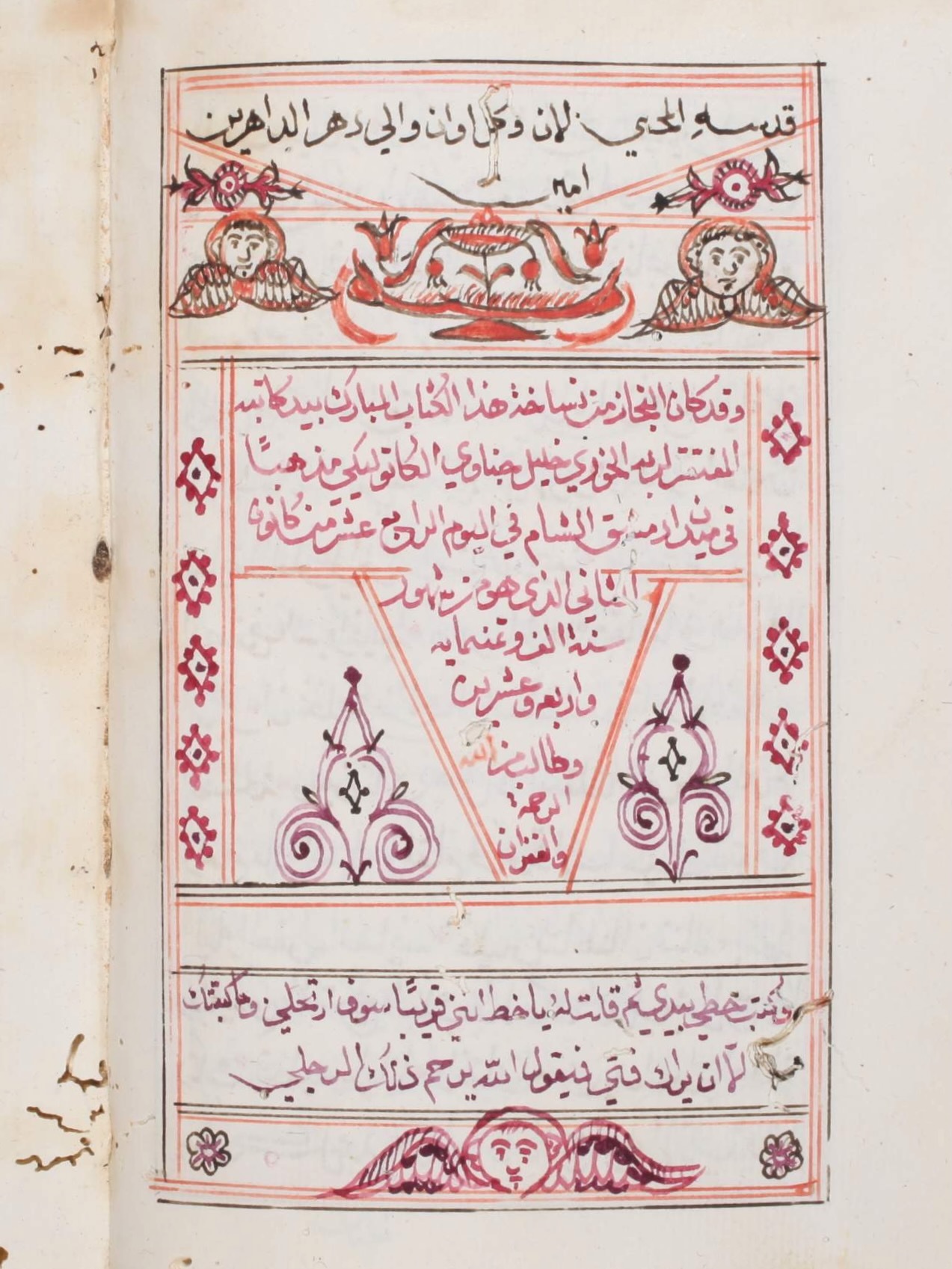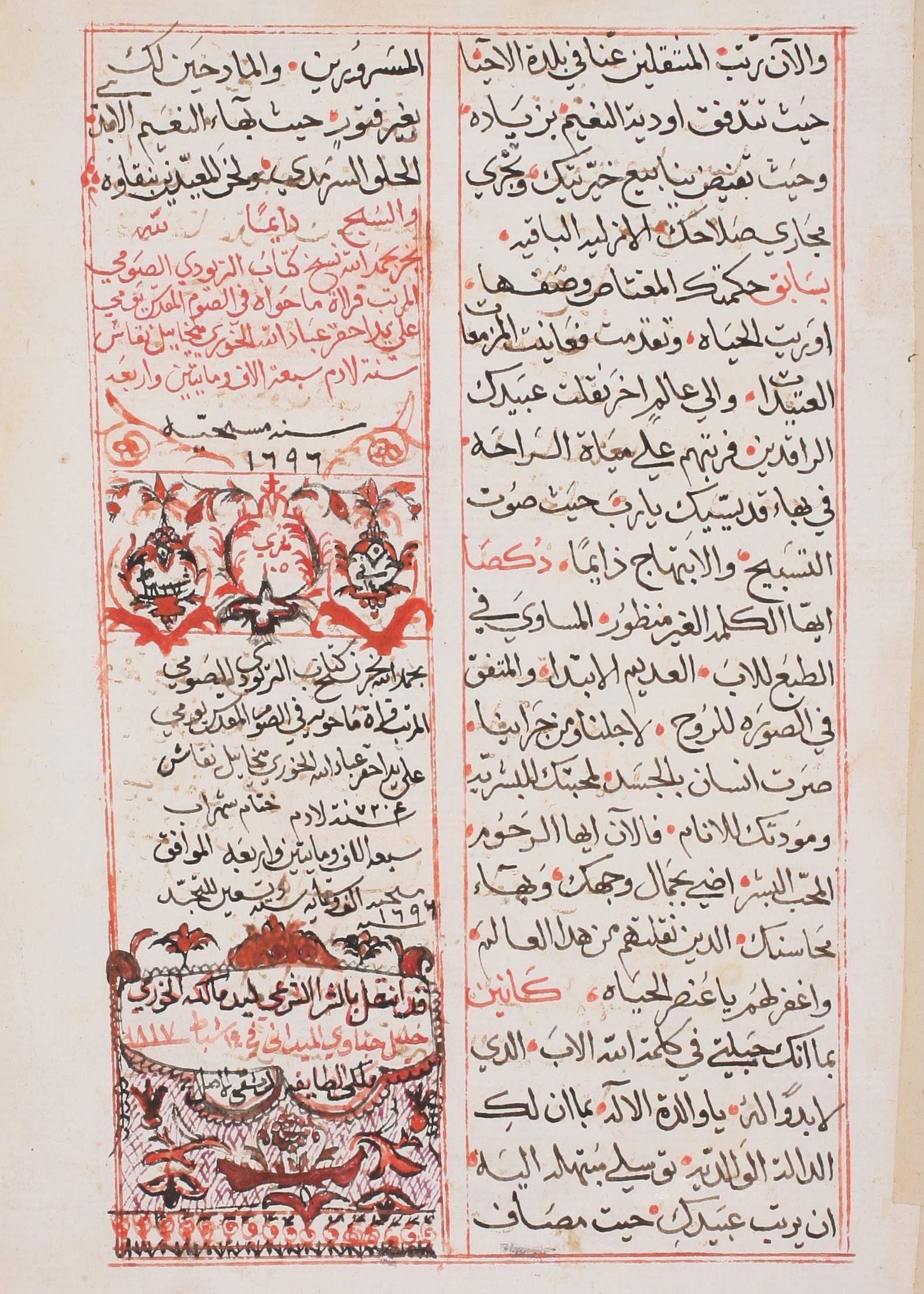Khalīl Janāwī: Scribe, Collector, And Artist From Al Mīdān Of Damascus
Khalīl Janāwī: Scribe, Collector, and Artist from al-Mīdān of Damascus
This story is part of an ongoing series of editorials in which HMML curators and catalogers examine how specific themes appear across HMML’s digital collections. From the Eastern Christian collection, Dr. Vevian Zaki shares a story about Scribes.
Khalīl ibn Jirjis Janāwī was a scribe, a collector of manuscripts, and an artist who was active for nearly 50 years in Damascus, Syria, during the end of the 18th through the first half of the 19th centuries. HMML Reading Room preserves 15 manuscripts transcribed, decorated, or purchased by Janāwī. In this story, we will have a closer look at what his colophons and marginal notes demonstrate, and how he identified himself through words and silence.

Scribes of Christian Arabic manuscripts typically identified themselves by noting their geographic region (city or village) and their religious denomination. The denominational aspect gained special significance in the 18th-century Near East after the conversion of some Christians from indigenous denominations to Catholicism.
For example, the division of the Melkite Greek Orthodox Church resulted in the establishment of the Melkite Greek Catholic Church in 1724 CE. In manuscripts, it’s common to see scribes from the Orthodox Church stress the fact that they are Orthodox. Scribes belonging to the newer denomination kept describing themselves as Melkites, but also added the designation ‘Catholic.’
In the case of Khalīl Janāwī, the situation was slightly different. Janāwī was not, in general, interested in denoting the church he belonged to. Some of his manuscripts mention nothing about his denomination (see, for example, folio 1r in SPFH 00112, copied in 1803 CE; and folio 136v in USJ 01725, copied in 1824 CE). In the manuscripts available in HMML Reading Room, Janāwī first identified with a denomination in 1802 CE, but it was enough for him at the time to describe himself inconclusively as Malkī al-ṭāʼifah (Melkite by denomination). It was only in a manuscript copied more than 25 years later, between December 1823 and January 1824 CE (SPFH 00051), that he clearly referred to himself as Catholic or kāthūlīkī madhhabā.

Janāwī always introduced himself in his colophons as al-khūrī or the priest, yet no church, monastery, or patriarch is ever referred to in this context. So, we are left in complete darkness as to where Janāwī served as a priest. Janāwī never mentions a commissioner of the manuscripts he copied either. It is also worth noting that he copied several liturgical manuscripts, and in one case he copied a particular liturgical text—the Octoechos—twice (SPFH 00068 and GCPD 00161). All of this implies that he produced the manuscripts for himself and his community.
This lack of information does not mean that it was difficult to discover Janāwī’s denomination. It is feasible that readers of Janāwī’s manuscripts could recognize his Catholic affiliation by observing the Catholic texts that he copied. In his early career, for instance, he copied the Arabic translation of the Compendiosae institutiones theologicae by Jean Claude de la Poype de Vertrieu (SPFH 00116).
A Man From al-Mīdān
The matter, then, is not to solve the puzzle of Janāwī’s Christian affiliation, but rather to see what was important to him for self-identification. Janāwī appears to have valued above all the details of his geographic origin and location. Following common practice, he acknowledged his origin as the city of Damascus. What was less common was his specification of his origin from a particular suburb within Damascus: al-Mīdān or “the Square.” In 12 out of the 15 manuscripts, he recorded his relation to this suburb. Not only were his roots in al-Mīdān, but this suburb was also where he lived and copied his manuscripts. He described himself as Mīdānī (a man from al-Mīdān), and at least once he used al-Mīdānī as a family name.

The reasons behind this pride and loyalty of Janāwī towards al-Mīdān are ambiguous. Historically, al-Mīdān was one of the new expansions of the city of Damascus outside its walls to the southwest. It was one of the main locations where Christians who came from the countryside, in particular from Ḥūrān, settled during the Ottoman period, and Janāwī’s family was likely one of these families.
This internal Christian migration to al-Mīdān was inaugurated in the late 16th century, however numbers significantly increased in the first half of the 19th century. Evidence of this is the building of three churches there (two Greek Catholic and one Greek Orthodox) in the 1830s CE. While some of these Christians were poor, others owned their houses and enjoyed a higher financial status. Judging from the ability of Janāwī to purchase manuscripts, and from the quality of the manuscripts that he copied (for example, the number of colors he employed), we can gather that he belonged to the latter group.

In April 1848 CE, Janāwī bought a liturgical manuscript (GCPD 00161). He most likely passed away shortly afterward, since a waqf (endowment note) dated December of the same year informs us that his brothers Mūsá, Shaḥādah, and Niqūlā endowed this same manuscript in commemoration of their father, Jirjis Janāwī, to the Church of the Lady in al-Mīdan. Another manuscript in his collection (GCPD 00167) was endowed to the same church, according to an anonymous waqf note.
It is not clear where and how the rest of his manuscripts were distributed before they found their way to the collections of the Société des Missionnaires de Saint Paul (Melkite Greek Catholic) in Ḥarīṣā, Lebanon, Université Saint-Joseph in Beirut, Lebanon, and the library of the Melkite Greek Catholic Church, Patriarchate of Antioch in Damascus, Syria, where they are housed now. At any rate, some of his manuscripts found a home for a while in his favorite place, al-Mīdān.
Further Reading:
Briggite Marino. Le faubourg du Mīdān à Damas à l’époque ottomane, Damascus (1997).
Linda Schatkowski Schilcher. Families in Politics: Damascene Factions and Estate in the 18th and 19th centuries, Stuttgart (1985).




